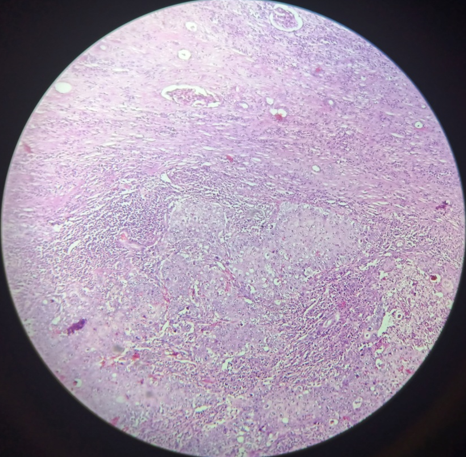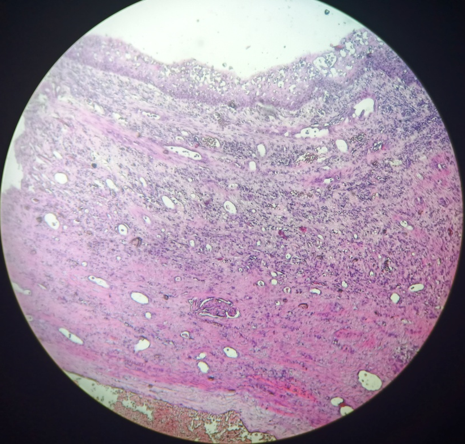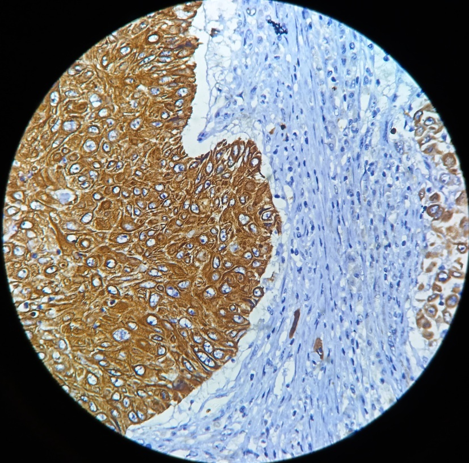Introduction
Cancer is one of the major causes of mortality in the world.1 Kidney cancer is considered as the most deadly cancer of the urinary tract.2 It is the ninth and fourteenth common cancer cases in men and women, respectively. Also, it is the sixteenth cause of death from cancer in the world.3 Squamous cell carcinoma (SCC) of the kidney is an extremely rare entity, constitutes less than 1% of all urinary tract neoplasms.4 and is mostly associated with long standing renal stone disease. This tumor has a poor prognosis because of its aggressive nature.5
Case Report
A 67-year-old female patient presented with complaints of pain abdomen and hematuria from last two weeks. Ultrasound examination revealed left kidney mass with nephrolithiasis. CT scan of abdomen showed large lobulated enhancing partially exophytic necrotic mass involving the upper-mid pole of left kidney favours the possibility of exophytic left renal cell carcinoma. The patient was operated in the surgery department and nephrectomy specimen was send to our department of pathology, GGS Medical College, Faridkot.
Gross Examination
The left kidney was found to be enlarged in size, measuring 12 cm × 7 cm × 6 cm. Cut section showed whole of the renal parenchyma replaced by grey white necrotic growth along with cystic areas filled with mucoid material and multiple yellow-brown colored stones (Figure 1). Grossly the growth was found involving the capsule. Ureter identified measuring 3cm in length. Cut section of perinephric fat showed focal grey white areas.
Microscopic examination
Hematoxylin and eosin stained tissue sections showed a cellular tumor with tumor cells arranged in nests. Individual tumor cells have round to oval nuclei, vesicular chromatin, prominent nucleoli and moderate amount of eosinophilic cytoplasm (Figure 2). The adjacent urothelium of pelvicalyceal system showed metaplasia and is replaced by stratified squamous lining (Figure 3). On immunohistochemistry by AEI/AE3 shows strong cytoplasmic staining of tumor cells (Figure 4). Pathological diagnosis of Moderately-Differentiated Squamous Cell Carcinoma of kidney was given. Tumor mass was involving the renal capsule and perinephric fat. Ureter and renal vessels were free of tumor.
Discussion
Primary renal squamous cell carcinoma is an extremely rare entity. Most squamous cell carcinoma of the kidney are moderately or poorly differentiated. Squamous cell carcinoma of kidney are more invasive than transitional cell carcinomas at diagnosis.5, 6 The patients usually presented with advanced stage, making surgical resection difficult. This tumor has poor response to surgery, radiotherapy and chemotherapy resulted in a poor prognosis and short survival.6, 7 Renal squamous cell carcinoma is mostly associated with chronic infections, renal calculi, radiotherapy or any factor that can irritate the urothelium. Normally the urothelium has transitional lining. Due to chronic irritation by stones it undergoes squamous metaplasia of lining epithelium which leads to dysplasia and become carcinogenic.8, 9 In our case chronic irritation occurs by stones which leads to squamous metaplasia of urothelial lining and develops into cancer.
Previous studies in which squamous cell carcinoma of kidney is documented are
Table 1
|
Study |
Laterality |
Site |
Nephrolithiasis |
|
Hipparagi SB et al in 2016 10 |
Right |
Middle and Lower pole |
Present |
|
TK Sahoo et al in 2015 11 |
Right |
Upper Pole |
Absent |
|
Ghosh P et al in 2014 12 |
Right |
Lower Pole |
Absent |
|
Salehipour M et al in 2019 13 |
Right |
Whole Kidney |
Present |
|
Lunney A et al in 2019 14 |
Right |
Upper Pole |
Present |
|
Our Study |
Left |
Whole Kidney |
Present |
Table 1 Shows:
Right kidney is most frequently affected in studies conducted by Hipparagi et al, TK Sahoo et al, Ghosh P et al, Salehipour M et al and Lunney A et al. But in our study Left kidney is involved by tumor.
Lower pole is involved in studies conducted by Hipparagi and Ghosh and upper pole is involved in studied conducted by TK Sahoo et al and Lunney A et al. Our study is in concordance with Salehipour M et al involving the whole kidney.
Nephrolithiasis is mostly associated in these studies, our case also shows association with nephrolithiasis.
Imaging techniques can show hydronephrosis, stones, and solid mass, but these findings are not specific for renal squamous cell carcinoma. Therefore, histopathological studies are very important for diagnosis. As compared to previous case reports, very little has been documented about squamous cell carcinoma of whole renal parenchyma. In our case whole kidney is involved by the tumor and is associated with nephrolithiasis.
Conclusion
Primary renal squamous cell carcinoma is an extremey rare tumor of upper urinary tract. It shows a strong association with nephrolithiasis. Imaging features on renal squamous cell carcinoma are non-specific. Histopathological findings are very important in the diagnosis of renal squamous cell carcinoma.





